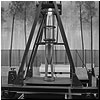| |
|
|
HISTORY: German research in the field of rocketry and space flight (1920-1945) | |||||||||||||||||||||||||||||||||||||||||||||||||||||||||||||||||||||||||||||||||||||||||||||||||||||||||||||||||||||||||||||||||||||||||||||||||||||||||||||||
|
|
Oberth: "Father of it all" In 1923, Professor of physics and math Hermann Oberth wrote "Die Rakete zu den Planetraumen," a fundamental work on the theory of rocketry and space travel. The book is widely credited for igniting the imagination of many future rocket enthusiasts in Germany and abroad. With its technological prowess and large educated class, Germany provided a fertile soil for the dreams about space travel. |
|||||||||||||||||||||||||||||||||||||||||||||||||||||||||||||||||||||||||||||||||||||||||||||||||||||||||||||||||||||||||||||||||||||||||||||||||||||||||||||||
|
|
Pioneers: Society for Space Travel In 1927, Johannes Winkler registered Verein fur Raumschiffahrt (Society for Space Travel) or shortly VfR, in the city of Breslau, Germany. Among its first members were Max Valier, Hermann Oberth and Walter Hohmann, now legendary names in the history of early spaceflight. (213) In August 1930, German officials certified that a rocket engine called Kegelduese developed by Professor Oberth generated seven kilograms of thrust for a period of 90 seconds. It was followed by a number of small experimental rockets tested at a converted army depot near Berlin. |
|||||||||||||||||||||||||||||||||||||||||||||||||||||||||||||||||||||||||||||||||||||||||||||||||||||||||||||||||||||||||||||||||||||||||||||||||||||||||||||||
 |
Rocket research by the German military Modest funds of the Society for Space Travel limited its activities to small experimental rockets and engines. However in the spring of 1932, the Mirak series of rockets developed by a group including Nebel and Von Braun, attracted the attention of the Ordnance Department of the Army. The German military saw missiles as a potential replacement for conventional long-range guns. Despite objections of a number of prominent members of the Society, its young member named Wernher von Braun accepted the invitation to take charge of a newly created missile development lab of the German Army on November 1, 1932. |
|||||||||||||||||||||||||||||||||||||||||||||||||||||||||||||||||||||||||||||||||||||||||||||||||||||||||||||||||||||||||||||||||||||||||||||||||||||||||||||||
|
|
"Vengeance" weapons: V-1, V-2 and V-3 It would be hardly an exaggeration to say that the Space Age was born from the biggest catastrophe in the history of human civilization. Soon after Nazis grabbed power in Germany, all the work on rocketry was consolidated by the military, while the work of enthusiasts was quickly shot down. At the beginning of 1935, German Air Force, Luftwaffe, commissioned Von Braun and his team to develop a rocket engine providing auxiliary power to the aircraft. It was followed by the development of a full-fledged rocket plane. However, soon von Braun's team accepted another proposal from the German Army to develop a long-range ballistic missile. In April 1937, a growing team of rocket developers moved to a newly built state-of-the-art facility at Peenemunde. There, an expansive and diverse rocket development program was launched. In the meantime, German Air Force recruited another prolific engineer, Eugen Saenger (Sänger), to develop a rocket powered plane, later known as the Saenger-Bredt antipodal bomber. |
|||||||||||||||||||||||||||||||||||||||||||||||||||||||||||||||||||||||||||||||||||||||||||||||||||||||||||||||||||||||||||||||||||||||||||||||||||||||||||||||
| HARDWARE GUIDE | ||||||||||||||||||||||||||||||||||||||||||||||||||||||||||||||||||||||||||||||||||||||||||||||||||||||||||||||||||||||||||||||||||||||||||||||||||||||||||||||||
Overview of the German rocketry developed during 1933-1945:
|
||||||||||||||||||||||||||||||||||||||||||||||||||||||||||||||||||||||||||||||||||||||||||||||||||||||||||||||||||||||||||||||||||||||||||||||||||||||||||||||||